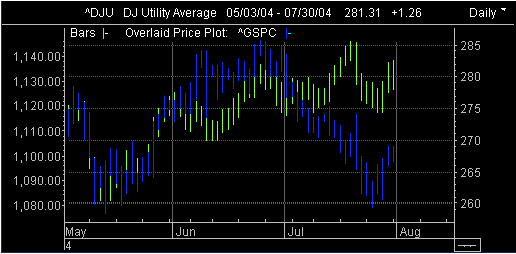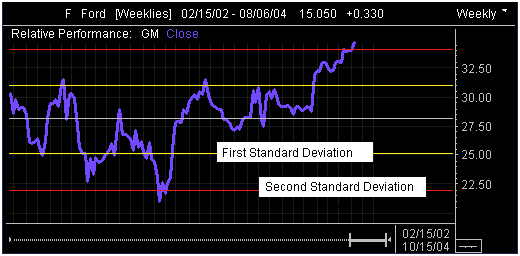"Quants" is Wall Street's name for market researchers who use quantitative analysis to develop profitable trading strategies. In short, a quant combs through price ratios and mathematical relationships between companies or trading vehicles in order to divine profitable trading opportunities. During the 1980s, a group of quants working for Morgan Stanley struck gold with a strategy called the pairs trade. Institutional investors and proprietary trading desks at major investment banks have been using the technique ever since, and many have made a tidy profit with the strategy.
It is rarely in the best interest of investment bankers and mutual fund managers to share profitable trading strategies with the public, so the pairs trade remained a secret of the pros (and a few deft individuals) until the advent of the internet. Online trading opened the lid on real-time financial information and gave the novice access to all types of investment strategies. It didn't take long for the pairs trade to attract individual investors and small-time traders looking to hedge their risk exposure to the movements of the broader market.
What Is Pairs Trading?Pairs trading has the potential to achieve profits through simple and relatively low-risk positions. The pairs trade is market-neutral, meaning the direction of the overall market does not affect its win or loss.
The goal is to match two trading vehicles that are highly correlated, trading one long and the other short when the pair's price ratio diverges "x" number of standard deviations - "x" is optimized using historical data. If the pair reverts to its mean trend, a profit is made on one or both of the positions.
An Example Using StocksTraders can use either fundamental or technical data to construct a pairs trading style. Our example here is technical in nature, but some traders use a P/E ratio or other fundamental factors to measure correlation and divergence.
The first step in designing a pairs trade is finding two stocks that are highly correlated. Usually that means that the businesses are in the same industry or sub-sector, but not always. For instance, index tracking stocks like the QQQQ (Nasdaq 100) or the SPY (S&P 500) can offer excellent pairs trading opportunities. Two indices that generally trade together are the S&P 500 and the Dow Jones Utilities Average. This simple price plot of the two indices demonstrates their correlation:

For our example, we will look at two businesses that are highly correlated: GM and Ford. Since both are American auto manufacturers, their stocks tend to move together.
Below is a weekly chart of the price ratio between Ford and GM (calculated by dividing Ford's stock price by GM's stock price). This price ratio is sometimes called "relative performance" (not to be confused with the relative strength index, something completely different). The center white line represents the mean price ratio over the past two years. The yellow and red lines represent one and two standard deviations from the mean ratio, respectively.
In the chart below, the potential for profit can be identified when the price ratio hits its first or second deviation. When these profitable divergences occur it is time to take a long position in the underperformer and a short position in the overachiever. The revenue from the short sale can help cover the cost of the long position, making the pairs trade inexpensive to put on. Position size of the pair should be matched by dollar value rather than number of shares; this way a 5% move in one equals a 5% move in the other. As with all investments, there is a risk that the trades could move into the red, so it is important to determine optimized stop-loss points before implementing the pairs trade.

An Example Using Futures Contracts
The pairs trading strategy works not only with stocks but also with currencies, commodities and even options. In the futures market, "mini" contracts - smaller-sized contracts that represent a fraction of the value of the full-size position - enable smaller investors to trade in futures.
A pairs trade in the futures market might involve an arbitrage between the futures contract and the cash position of a given index. When the futures contract gets ahead of the cash position, a trader might try to profit by shorting the future and going long in the index tracking stock, expecting them to come together at some point. Often the moves between an index or commodity and its futures contract are so tight that profits are left only for the fastest of traders - often using computers to automatically execute enormous positions at the blink of an eye.
An Example Using OptionsOption traders use calls and puts to hedge risks and exploit volatility (or the lack thereof). A call is a commitment by the writer to sell shares of a stock at a given price sometime in the future. A put is a commitment by the writer to buy shares at a given price sometime in the future. A pairs trade in the options market might involve writing a call for a security that is outperforming its pair (another highly correlated security), and matching the position by writing a put for the pair (the underperforming security). As the two underlying positions revert to their mean again, the options become worthless allowing the trader to pocket the proceeds from one or both of the positions.
Evidence of ProfitabilityIn June of 1998, Yale School of Management released a paper written by Even G. Gatev, William Goetzmann, and K. Geert Rouwenhorst who attempted to prove that pairs trading is profitable. Using data from 1967 to 1997, the trio found that over a six-month trading period, the pairs trade averaged a 12% return. To distinguish profitable results from plain luck, their test included conservative estimates of transaction costs and randomly selected pairs. You can find the full 34-page document here.
Those interested in the pairs trading technique can find more information and instruction in Ganapathy Vidyamurthy's book Pairs Trading: Quantitative Methods and Analysis, which you can find here.
The Bottom LineThe broad market is full of ups and downs that force out weak players and confound even the smartest prognosticators. Fortunately, using market-neutral strategies like the pairs trade, investors and traders can find profits in all market conditions. The beauty of the pairs trade is its simplicity. The long/short relationship of two correlated securities acts as a ballast for a portfolio caught in the choppy waters of the overall market. Good luck with your hunt for profit in pairs trading, and here's to your success in the markets.